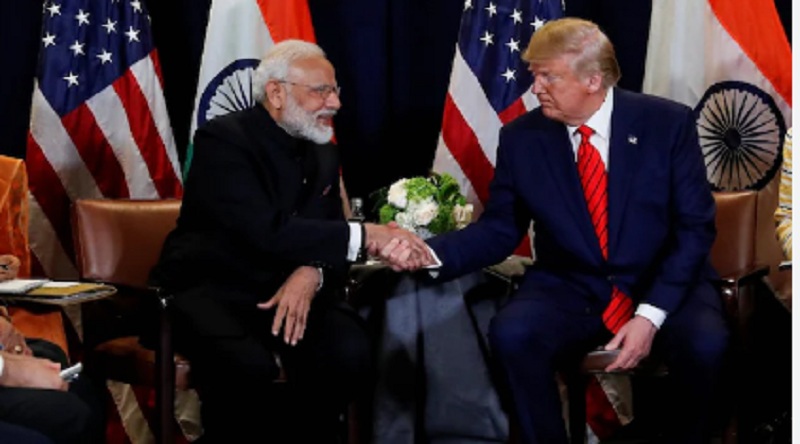By Somesh Mathur
The Make America Great Again (MAGA) agenda is in full swing.
Shortly after taking charge, President Donald Trump announced additional tariffs on America’s three largest trading partners —Mexico, Canada and China. Though tariffs on Mexico and Canada have been paused, those on Chinese imports have come into effect.
China has responded with counter-tariffs on US imports.
Such measures could disrupt global growth and impact critical sectors such as retail, technology and manufacturing that rely heavily on the global supply chain and imported inputs.
For India, these targeted tariffs and imminent protectionist policies will create complex challenges and opportunities.
Trump’s renewed emphasis on decoupling from China, for instance, can serve as an opportunity.
Three recent developments suggest India might be the beneficiary of the pushback on China.
At the first Quad ministerial meeting after Trump took charge, the US, Australia, India and Japan issued a united warning against coercive actions to alter status quo in the Indo-Pacific. This is a clear yet indirect message to China regarding its assertive maritime activities.
All four countries of the Quad share concerns over China’s growing influence in the region.
Second, under Trump 2.0, the ‘China Plus One’ strategy is likely to get a major push across the board. This strategy involves diversification of the production base and investment operations of multinational companies to hedge against risks in China.
Increasingly, US companies are shifting their production base to alternative markets such as India and Vietnam to reduce dependency on China and boost stability.
Here, India can position itself as a viable alternative to attract foreign direct investment and benefit from trade diversion.
Companies such as Apple Inc., for instance, have already begun expanding operations in India — beyond assembly and sales — signalling the country’s growing potential to play a central role in the global trade realignment.
Soon after the Quad ministerial meeting, Marco Rubio, US secretary of state, held his first bilateral meeting with S Jaishankar, India’s external affairs minister.
Discussions centred on regional challenges and opportunities for cooperation in critical and emerging technologies, defence, energy and promoting a free and open Indo-Pacific.
Despite this healthy diplomatic conversation with the Trump 2.0 administration, India must strategically navigate the turbulent trade waters that lie ahead.
Tariff wars
The US already levies hefty tariffs on key commodities such as cereals and processed foods (193 percent), dairy products (188 percent), oilseeds and oils (164 percent).
In due course, India’s core export sectors such as pharmaceuticals, textiles, and IT too will likely face higher tariffs.
Such retaliatory measures raise concerns about the future of these powerhouse sectors in the US market.
Higher tariffs can severely impact the economy. If the US escalates the average tariff rate up to 20 percent on Indian exports, and India retaliates by increasing its average tariffs proportionately, it would trigger several consequences such as low competitiveness, economic uncertainty, job losses, trade imbalance and decline in investments.
Instead of engaging in a counter-productive tariff war, India’s strength lies in leveraging the friendly relationship between Prime Minister Narendra Modi and President Trump for mutually beneficial tariff reductions.
The Rubio-Jaishankar meeting signals positive momentum in this regard. Besides, in its latest budget, the Indian government has also lowered tariffs on some imports from the US.
A viable strategy for addressing trade imbalance would be stimulating domestic consumption through tax cuts.
This would boost consumption and generate income in the local economy, thereby increasing trade flow and reducing the need for tariff escalation.
Eastward Ho
With the rising tide of protectionist policies under Trump 2.0, India might also need to strengthen its ‘Look East’ strategies.
Senator Rubio has pushed for a pragmatic and realistic US approach towards the Association of Southeast Asian (ASEAN) countries.
India’s persistent trade deficit with China and the ASEAN countries has been due to the high volume of imports for production.
For example, India has a thriving smartphone assembly ecosystem, but it relies heavily on imported inputs. China supplies key components such as batteries, displays and chipsets. Vietnam, Malaysia, and Thailand complement this by supplying supporting electronic components.
The final assembly takes place in India, where companies such as Foxconn and Samsung produce smartphones for both domestic and export sales.
To gain an edge in the supply chain, India must focus on restructuring its industrial and trade policies to boost exports in high-potential sectors.
Another challenge will be the restrictions on the movement of skilled and unskilled labour and immigration controls under Trump 2. These will create a formidable challenge for India’s IT and outsourcing sectors that rely heavily on the US market.
There’s some consolation here, though. The demand-supply gap for STEM (Science, Technology, Engineering, Management) professionals in the US and the high cost of hiring local talent suggests that India’s IT sector may retain its relevance, at least in the short run.
In the long term, India could diversify its outsourcing operations and explore new markets.
India’s involvement in the Indo-Pacific Economic Framework for Prosperity (IPEF) offers another avenue for growth, focusing on the four pillars of trade, supply chain, fair economy and clean economy.
Here, India is set to play a crucial role, paving the way for stronger strategic and economic ties within the region.
With its ‘America First’ focus, if the US withdraws from the consortium, India could benefit from the bloc propelling Asia-led growth. The US’s exit could intensify trade flows within the bloc, fostering faster growth as member countries capitalise on existing supply chains and infrastructure linkages.
Our analysis, using an international trade database, shows that deeper liberalisation within the bloc could increase trade for India from 3.55 percent to 4.19 percent.
Drill, baby, drill
Climate goals remain sidelined in President Trump’s agenda as his second term shifts the focus back to fossil fuels.
The US will withdraw from the Paris Climate Agreement, reversing climate regulations and promoting fossil fuel development. However, major oil companies have said this move could hinder their transition to cleaner energy sources.
In the short run, this policy may boost domestic oil production in the US and potentially lower oil prices. However, it will adversely impact the oil and gas industry which prefers to maintain high prices.
For India, these policies could prove to be a double-edged sword. Increased oil production in the US will help reduce its dependence on Russia.
But it could also intensify competition for its energy exports to Europe.
Amid these shifts, India must prioritise climate-friendly technologies and projects. Strengthening cooperation with Japan and Australia under the clean economy pillar of the IPEF will be crucial to advancing zero-emission goods and services.
Finally, America’s withdrawl from the World Health Organisation and the IPEF, signal a retreat from both multilateralism and regionalism.
However, the existing deep economic interdependencies are likely to limit the extent of true realignment in global trade, presenting a mixed bag of opportunities and challenges for India.
Dr Somesh Mathur is Professor, IIT Kanpur. Dr Anusree Paul is Associate Professor, School of Management, BML Munjal University, Haryana. Mathur and Paul are trade economists, and work on empirical economics, trade agreements and trade policy. Significant content for this article was contributed by Dr Nikhila Menon, Senior Fellow, Infisum Modelling and former Director, Ministry of Finance, Government of India.
Originally published under Creative Commons by 360info™.















